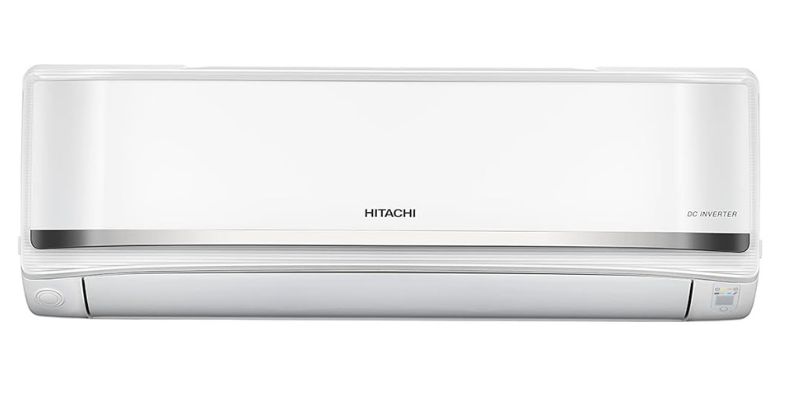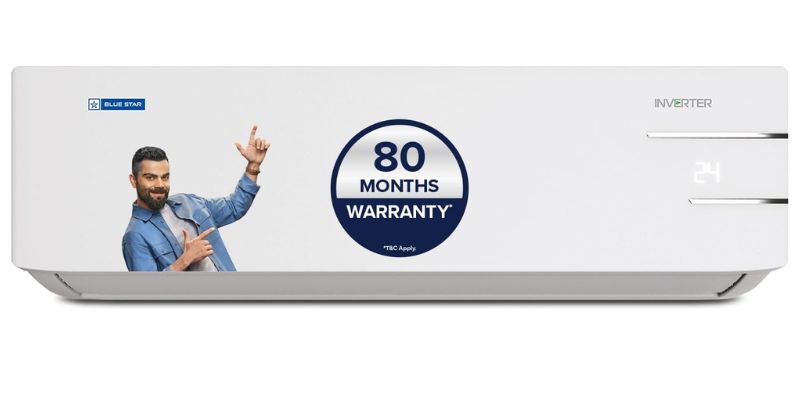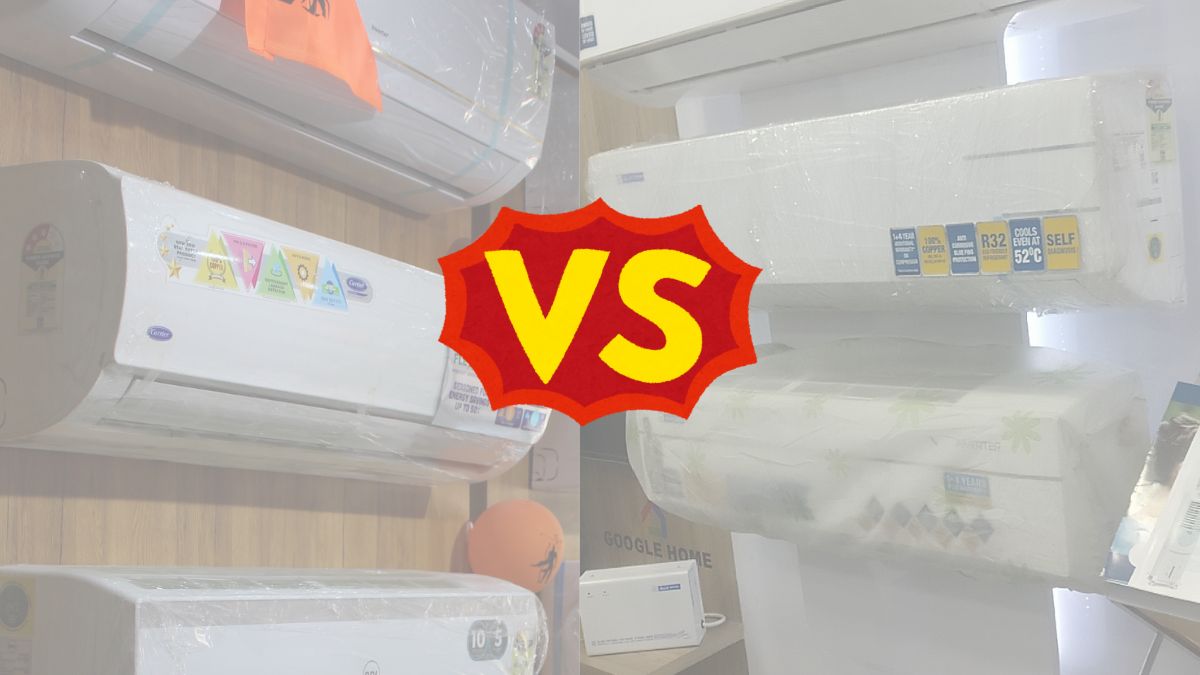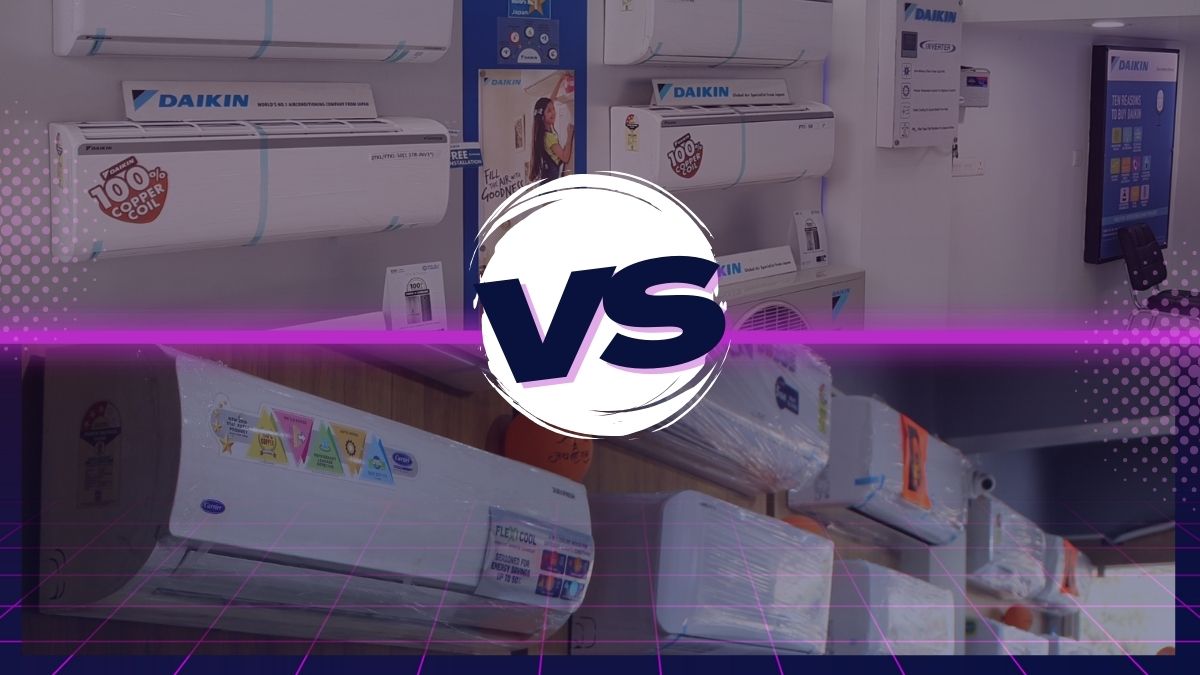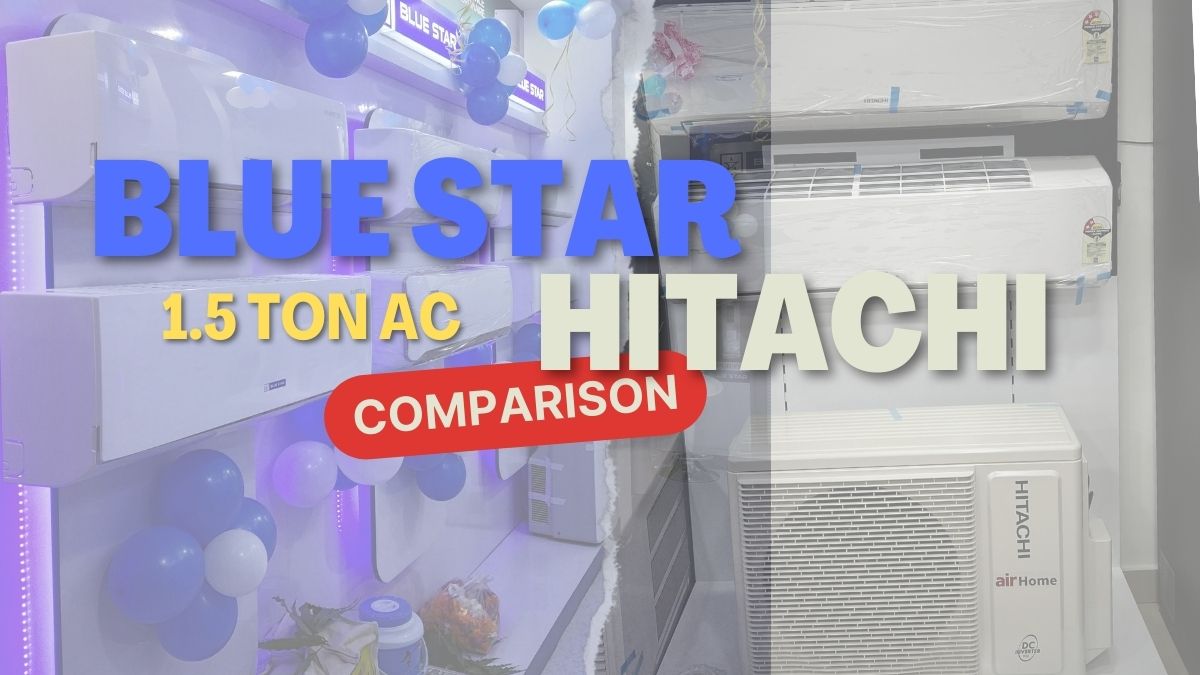
If you are looking for a new 1.5 ton AC for a medium-sized room (150-180 sq ft), it is highly likely you have shortlisted these two 5 star AC brands:
- Blue Star – trusted Indian brand.
- Hitachi – Japanese technology.
Both Blue Star and Hitachi offer inverter split ACs in the 5 star rating category, how do you pick the right one? I have comprehensively analysed the model, I have will look at their cooling capacity, energy efficiency, features, noise level price and other factors to help you choose the better 1.5-ton 5-star AC for your home.
Here is a comparison table of the key features of the Blue Star Vs Hitachi AC 1.5 Ton 5 Star 2024 model.
Similarities between Blue Star and Hitachi ACs
While there are some differences in technology and features, I have seen that Blue Star and Hitachi ACs have the following similarities:
Inverter Compressor
Both AC models come with inverter compressors that adjust cooling based on heat load. This makes them energy efficient.
1.5 Ton Capacity
I have found that both Blue Star and Hitachi ACs have 1.5 ton capacity that is ideal for 150 sq ft room sizes.
Copper Condenser Coil
Good thing I have seen is that both AC models have 100% copper condenser coils for better cooling and longevity.
Ambient Temperature
Both ACs can operate in temperatures of up to 54°C making them suitable for hot Indian summers.
Remote Control
The ACs can be controlled from anywhere in the room using the remote control.
Air Filtration
Both models have dust filters to provide clean air.
Self-Diagnosis
The ACs have self-diagnostic capability for easier and faster servicing.
Key Differences between the ACs
While basic specifications are similar, I have found some key differences between Hitachi and Blue Star 1.5 ton models:
01. Energy Efficiency Comparison
The Blue Star 1.5 Ton 5 Star Inverter AC has an ISEER value of 5.02 and annual electricity consumption of 770.98 units. It is certified by BEE with the latest 2024 5 star energy rating.
The Hitachi 1.5 Ton 5 Star Ice Clean Xpandable Plus Inverter AC has a matching ISEER value of 5.02 but slightly higher annual consumption of 813.13 units per year. It also meets the 2024 5 star energy standards.
Here is a comparison of the key energy efficiency parameters:
| Parameter | Blue Star AC | Hitachi AC |
| Star Rating | 5 Star | 5 Star |
| ISEER | 5.02 | 5.02 |
| Annual Electricity Consumption | 770.98 units | 813.13 units |
While the ISEER values are identical, I can see that the Blue Star AC consumes about 5% lower units yearly. This can add up to significant savings over the product lifetime of 8-10 years.
Both air conditioners utilize inverter compressors and copper coils for energy efficient cooling. However, Blue Star AC edges out Hitachi when it comes to power consumption due to its higher efficiency inverter technology.
For energy conscious buyers, Blue Star seems to be the clear winner in the energy efficiency category based on the lower annual electricity consumption.
02. Stabilizer-Free Operation
Voltage fluctuations are a major issue in India leading to AC malfunctions. So the stabilizer-free operation range is an important consideration while purchasing an air conditioner.
The Blue Star 1.5 Ton 5 Star Inverter Split AC can operate within a wide voltage range of 160V – 270V without requiring an external stabilizer.
The Hitachi 1.5 Ton 5 Star Ice Clean Xpandable Plus Inverter AC has a more limited stabilizer-free operation range of 160V – 230V based on its design.
Here is a comparison of the voltage fluctuation handling capacity:
| Parameter | Blue Star AC | Hitachi AC |
| Stabilizer-Free Operation Range | 160V – 270V | 160V – 230V |
The Blue Star AC can handle a much wider voltage range, from 160V all the way up to 270V. In contrast, the Hitachi AC cannot handle voltage fluctuations beyond 230V.
This gives Blue Star AC an advantage in being able to operate smoothly during sudden voltage drops or rises without external stabilizer installation. This saves cost and space while also protecting the AC during unexpected power fluctuations.
03. Cooling Capacity Comparison
The Blue Star 1.5 Ton AC has a capacity of 5050 Watts and uses a high efficiency inverter compressor. It can effectively cool rooms sized between 111-150 sq ft.
The Hitachi 1.5 Ton AC has a slightly higher 5275 Watts cooling capacity. It uses Hitachi’s proprietary inverter compressor technology for meeting cooling demands. It is also suitable for 150-180 sq ft rooms.
Here is a head-to-head comparison:
| Specification | Blue Star AC | Hitachi AC |
| Tonnage | 1.5 Ton | 1.5 Ton |
| Cooling Capacity | 5050 Watts | 5275 Watts |
| Compressor Type | High efficiency inverter compressor | Hitachi inverter compressor |
| Ideal Room Size | 111-150 sq ft | 150-180 sq ft |
While both air conditioners have comparable cooling power, Hitachi edges out Blue Star with its higher capacity inverter compressor tailored specifically for the model. This gives Hitachi about 5% extra cooling power.
Considering the technical specifications and special technologies used, Hitachi seems to be the winner when it comes to delivering maximum cooling capacity to quickly chill your room.
04. Noise Level Comparison
The Blue Star 1.5 Ton 5 Star Inverter AC has noise levels ranging from 34 dB on the lowest fan setting up to 49 dB on the highest setting.
The Hitachi 1.5 Ton 5 Star Ice Clean Xpandable Plus Inverter AC operates even more silently with a noise band of 34 dB to 46 dB based on the fan speed.
Let’s compare the noise output:
| Parameter | Blue Star AC | Hitachi AC |
| Lowest Fan Speed Noise | 34 dB | 34 dB |
| Highest Fan Speed Noise | 49 dB | 46 dB |
While both air conditioners are relatively quiet, the Hitachi operates 3 dB lower at the highest fan speed. A 3 dB reduction is equivalent to cutting noise in half.
Hitachi’s super silent fan design with aerodynamic air circulation results in lower noise. This makes it the winner when comparing the noise output.
So for customers who value a very quiet AC, the Hitachi seems to be the better choice compared to Blue Star when judging the noise levels.
05. Smart Features Comparison
Blue Star AC AI that monitors indoor and outdoor temperatures, company claims it optimizes cooling accordingly, I found it really works well. This allows real-time adaptive cooling based on changing conditions. Another good thing I have found, it also has a unique 5-in-1 convertible cooling mode, allows to customize between 5 capacity levels for personalized experiences, it can be controlled through remote. I could not find Wi-Fi connectivity options and it can only be operated via remote.
In contrast, the Hitachi AC is also equipped with smart technology that rapidly expands cooling capacity under adverse conditions like peak summers to quickly achieve the set temperature. It also has 6 intelligent sensors that monitor parameters to maintain ideal temperature and diagnose errors. I was able to set 3 personalized cooling modes, it activated via one-touch. Like the Blue Star, the Hitachi can also be operated via remote but lacks WiFi connectivity.
The expandable capacity, multiple sensing, self-diagnosis, and customizable modes give Hitachi a lead. However, the Blue Star also offers temperature-based optimization and flexibility in cooling levels. But the lack of connectivity options in both models takes away some points.
06. Maintenance Comparison
Proper maintenance is required for air conditioners to deliver optimum cooling and efficiency year after year. Let’s see how Blue Star and Hitachi ACs compare on this aspect.
Both AC models have 100% copper coils that require minimal maintenance as copper resists corrosion. The condenser coils can easily handle weather wear and tear.
Blue Star and Hitachi ACs utilize dust filters that are washable and reusable.
Hitachi AC has a unique filter clean indicator that alerts you when filter cleaning is due.
For self-cleaning, both ACs provide dry mode operation to remove moisture and prevent mold growth inside. No major maintenance of the interior components is required.
Here is a quick comparison:
| Parameter | Blue Star | Hitachi |
| Copper Coil Maintainability | Excellent | Excellent |
| Filter Maintenance | Washable | Washable + Indicator Alert |
| Dry Mode | Yes | Yes |
Considering the even maintenance needs, it is difficult to pick a clear winner.
Which is Better for 150 sq ft Room Size?
For a medium-sized room of around 150 sq ft, which AC is more suitable between Blue Star and Hitachi?

The 1.5 Ton Blue Star AC provides a cooling capacity of 5050 Watts which is sufficient for effective cooling in a 150 sq ft bedroom or living room. Its capacity matches this mid-range room size.
The 1.5 Ton Hitachi AC delivers a cooling of 5275 Watts, which is 5% higher. This additional cooling power, gives fast temperature pull-down even in slightly larger rooms of 150-180 sq ft.

Extra cooling power and features, Hitachi AC seems better suited for a 150 sq ft room due to its higher capacity and low noise operation on low speed.
Which is Better – Blue Star or Hitachi AC?
Analyzing the parameters, here is my verdict on Blue Star vs Hitachi 1.5 ton 5 star AC:
Reasons to Buy Blue Star AC
- Higher energy efficiency
- Lower noise levels
- WiFi connectivity features
- Stabilizer-free operation
Reasons to Buy Hitachi AC
- Wider range of cooling modes
- Slightly better cooling capacity
- Japanese technology
- Lower cost
Read more comparisons:
- Hitachi Vs LG AC 1.5 Ton 5 Star
- Carrier Vs Blue Star AC 1.5 Ton 5 Star Rating
- Blue Star Vs Daikin AC 1.5 Ton 5 Star
- Hitachi Vs Panasonic AC 1.5 Ton 5 Star
The Verdict: Hitachi is the Winner but Blue Star is Close Behind
The Hitachi AC edges out in certain key parameters like cooling capacity, low noise, and long air throw. With 5275W cooling capacity versus 5050W in Blue Star, the Hitachi cools rooms faster. Personalized modes make Hitachi more intelligent. The dedicated sleep mode and LED temperature display also give Hitachi an advantage.
However, the Blue Star AC is very close behind and excels in some areas. Both model has similar ISEER rating. It also operates silently with noise levels of 34-49dB compared to 34-46dB in the Hitachi model. The higher 637 CFM air flow volume in Blue Star also allows better air distribution.
The Hitachi is victorious by a small margin owing to better cooling, advanced features and modern technology integration. But for those prioritizing energy savings and ultra-low noise, the Blue Star can be the better choice. So while Hitachi takes the crown, the Blue Star puts up a tough fight and has its own merits. Both are great 1.5 ton 5 star split ACs from leading brands. But on the whole in this comparison, the Hitachi AC scores more points across parameters to emerge the winner.

